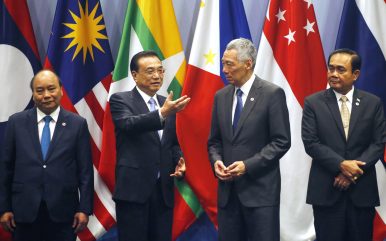By Prashanth Parameswaran
In recent years, even as China has criticized U.S. alliances in the Asia-Pacific, Beijing has also been working to develop its own new security partnerships in the region as part of its effort to shape the existing regional architecture. And while China continues to face challenges in doing so, in Southeast Asia in particular, Beijing has been making unprecedented inroads, from the holding of the first ASEAN-China Maritime Exercise last year to new arms sales to and institutionalized dialogues with Thailand and Malaysia. Though there has been scrutiny on individual manifestations of this trend, there has been a lack of attention to the systematic development of these partnerships, which could have great significance not just for Beijing’s own influence, but also the alignments of other countries like the United States and the wider regional security architecture.
In a new report for The Wilson Center, I attempt to fill this gap by examining China’s ongoing efforts to develop security partnerships for Southeast Asia, and the strategic implications for the region. In the report, based on an analysis of Chinese and Southeast Asian sources and conversations with regional officials familiar with these dynamics, I argue that the rise of Chinese security partnerships in the Asia-Pacific is not just a natural outgrowth of Beijing’s regional influence, but is propelled by strategic drivers, including Beijing’s efforts to develop a China-centric security order and a tendency for countries to accommodate Beijing’s rise. The outlines of Chinese strategic partnerships are already becoming clear, including new dialogues and facilities, and they are also becoming more complex and institutionalized.
The development of Chinese security partnerships has implications not just for the states themselves, but also for the region more broadly as well as the United States and its allies. China and relevant Southeast Asian states continue to see value in these partnerships for various reasons, including dealing with shared nontraditional security challenges, procuring defense equipment on more competitive terms, and generating leverage perceived to help better manage bilateral ties. But these partnerships can also raise challenges, whether it be the transparency and exclusivity of these relationships, broader anxieties about Beijing’s current behavior and longer-term ambitions, or governance challenges in some Southeast Asian states themselves, which can affect the genesis, nature, and development of these partnerships.
The report makes several recommendations for policymakers in China, Southeast Asia, and other key Indo-Pacific capitals about how to manage the rise of Chinese security partnerships in the Asia-Pacific. For its part, China needs to address concerns about its intenions and capabilities to increase regional receptiveness to these partnerships, including how they fit into existing regional arrangements such as ASEAN-led institutions and U.S.-led alliances and partnerships. Beyond what China can do, Southeast Asian governments and publics need to do their part to ease lingering doubts about these arrangements, including by pushing for greater transparency and taking into account how alignments can affect wider regional stability.
Other key actors in the Indo-Pacific region also have an important role to play. In particular, the United States and like-minded allies and partners should intensify efforts to develop alternatives for Southeast Asian states in areas such as arms sales where this is possible, including jointly where necessary. And even as these countries and other interested parties continue to accelerate capacity-building measures to help countries make more informed decisions about their alignments, they should also have clear and candid conversations with these countries and their publics about the impact that closer security ties with China could have on their own collaboration.
To be sure, the development of China’s strategic partnerships in Southeast Asia and the wider region is an ongoing process, and we may see evolutions in this process in the subregion as well as elsewhere in the Asia-Pacific region in the coming years. Nonetheless, even as we see elements of continuity and change take shape, it will be important to keep these implications in mind moving forward.
Note: The above article is based on a summary from a Wilson Center report released by the author. You can read the full report here (PDF).

